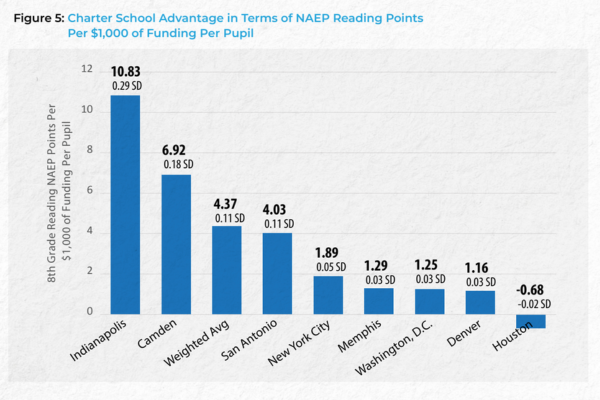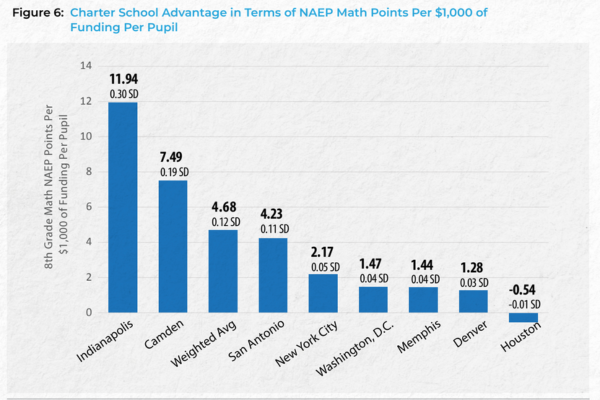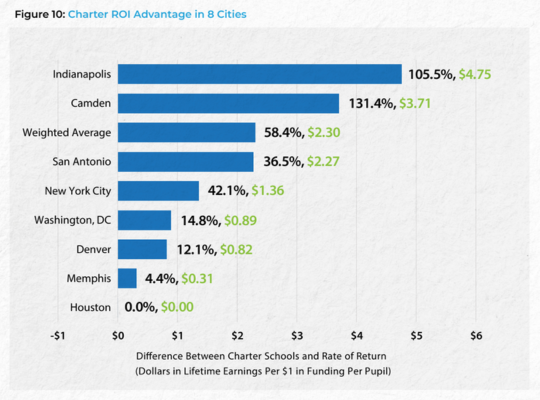University of Arkansas study shows Indianapolis charters as most cost-effective
Charter schools initially opened their doors to Indianapolis students and families in the fall of 2002. Their rapid growth and academic outcomes have attracted many national studies, including two studies in 2023 from the University of Arkansas.
In August of this year, researchers at the University of Arkansas published a study that examined the funding gap between charter schools and traditional district schools. Indianapolis had the third-largest funding disparity out of the 18 cities analyzed, with charter schools receiving an average of $7,863 less per pupil than district schools. That means charter school students in Indianapolis receive about 42.5% less in total annual funding than their peers in traditional district schools.
Today the University of Arkansas released a new study that examined charter schools’ return on investment in nine cities across the country. The study examines results from CREDO at Stanford University’s 2022 city-based studies on charter school performance and overlays those results with findings from the University of Arkansas’ charter school funding report. The researchers incorporated information from the National Assessment of Educational Progress (NAEP) Data Explorer and wage data from the Bureau of Labor Statistics to estimate both cost-effectiveness and return on investment for charter sectors in each of the nine cities.
NAEP, which is often referred to as the “nation’s report card,” is an assessment given regularly in all 50 states that helps families, educators, and community leaders measure learning trends. Find more information about the assessment at the NAEP website.
Study shows Indianapolis is the most cost-effective charter sector in the country for reading and math
Researchers compared the cost-effectiveness of charter schools and traditional public schools in each city they studied: Camden, New Jersey; Denver, Colorado; Houston, Texas; Indianapolis, Indiana; Memphis, Tennessee; New Orleans, Louisiana; New York City, New York;
San Antonio, Texas; and Washington, DC. They defined cost-effectiveness as the average estimated NAEP points earned per $1,000 in per-pupil funding.
This analysis found that Indianapolis, by far, is home to the most cost-effective charter sector in the country for both reading and math. You can find an overview of those findings in Figures 5 and 6 below, which are directly from the study.


Indianapolis charter schools have the largest lifetime ROI advantage out of all cities studied
Researchers also compared the expected return on investment (ROI) of charter schools and traditional public schools in a given city. They defined ROI as the amount a student will earn during their lifetime for every dollar invested in their education.
Indianapolis’ charter sector has the largest ROI advantage out of any city in the study (see figure 10 from the study below). This means that for every dollar invested in Indy charter students’ education, they can expect to earn an average of $4.75 more than their traditional public school peers throughout their lifetime.

Local charter schools use limited resources to drive strong outcomes
This study confirms what our community has seen from other national studies and recent ILEARN and SAT data:
- Students who attend Indianapolis charter schools make significantly more academic growth than their district peers. Charter school students are more likely to be students of color and quality for free or reduced lunch than their traditional district school peers.
- Indianapolis charter schools achieve these results while receiving $7,900 less in per-pupil funding than their district counterparts. Charter per-pupil funding is lower in Indianapolis than in any city studied.
This new study adds to a growing body of research demonstrating the effectiveness of Indianapolis charter schools. These results are a testament to the hard work of countless educators in our city. They are also a testament to the families who continue to choose these schools and advocate for their growth. If funded fairly, charter schools could achieve even larger results for more students across our city and state.

